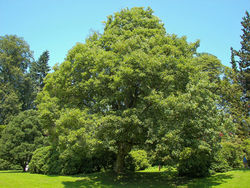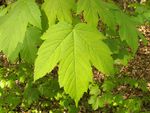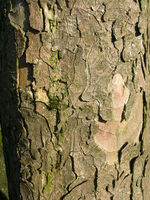Sycamore maple
| Sycamore maple |
|---|

|
| Scientific Classification |
|
| Scientific Name |
|
Acer pseudoplatanus |
| The sycamore maple tree losing its leaves during autumn |
The sycamore maple tree is a species of maple tree known by the scientific name Acer pseudoplatanus. The tree has an incredibly long life span of about 200 to 500 years. It also grows rapidly and grows very tall. This maple tree can't grow in the shade, but it can grow in pollutants, salt, and disturbed grounds. This sycamore tree doesn't start producing seeds until it is about 25 years old.Cite error: Invalid <ref> tag; invalid names, e.g. too many[1][2]
Body Design
Sycamore maple trees usually grow from 75 to 90 feet high with a width of 50 to 70 feet. The sycamore maple lives more than 200 years.When it grows next to other trees it lives close to around 250 years. Some individual trees are reported to have lived 500 to 600 years.Cite error: Invalid <ref> tag; invalid names, e.g. too many
Sycamore maple trees can tolerate air pollution and will thrive in city lots. The sycamore maple grows rapidly under moist soil and in full sun conditions, a sycamore maple tree can grow more than 24 inches a year. A sycamore maple tree seedling can reach 10 feet tall in one year and it can begin flowering in 6 to 7 years. Sycamores maple trees begin producing seeds when they are about 25 years old and produce the most seeds when they are between 50 and 200 years old.Cite error: Invalid <ref> tag; invalid names, e.g. too many
Life Cycle
After the leaves start appearing, the sycamore begins to flower. It starts flowering around April. After a time, the seeds begin to ripen in autumn. Their spiraling drop increases the time it takes for them to get to the ground, and so increases the probability that it will be further away from its parent because of the wind. The oldest a sycamore can live is around 500 years. Since this species grows and reproduces so rapidly many conservationists remove it from natural habitats to preserve the native plants. This tree also produces a sticky mucus when the leaves begin to decompose. It also boosts the earthworm numbers.[3]
Ecology
The sycamore maple is natural to birch, beech, and fir forests. It invades without hesitation disturbed environments like forest plantations, abandoned farmlands, brownfield lands, railway lines, roadside verges, hedgerows, native and semi-natural woodland and, in New Zealand, high country tussock grassland. It is a threat to the rare endemic Madeiran orchid, Dactylorhiza foliosa. It is able to grow in a wide range of soil types except heavy clay, but grows best on nutrient-rich, slightly calcareous soils.[4]
The sycamore maple is native to southern and central Europe and parts of western Asia. However, it has been planted widely as a decorative tree for centuries and is now growing in Great Britain and North America. Also, in Europe, they use sycamore maple tree timber wood for violins and wood panelling.[5]
Use and Management
This tree is so large that it wouldn't be able to live on a small landscape. When the leaves begin to fall in the autumn, it rains down leaves. The amount of leaves would take a lot of work to rake, even for an expert gardener; especially the leaves covering the gardeners flower beds. The tree may be beautiful, but exceedingly time consuming to care for.[6]
Since the sycamore maple can grow in either full sun or partial shade and on almost any well-drained soil, acid soil, or alkaline soil, you don't have to give it an extreme amount of care. The sycamore maple tree is quite adaptable to various soils and is also highly salt and pollution tolerant. Also, little pruning is needed to develop a good trunk and branch structure, but the sycamore maple is defenseless to the trunk and branch cankers. The sycamore maple tree grows well in disturbed sites like abandoned fields, roadsides, vacant parking lots and yards. The sycamore maple tree also grows on the edges of forests. It can grow in shade but it is able to grow in pollution, salt, and different soils.[7]
Video
Man teaching how to identify a sycamore tree.
References
- ↑ Sycamore Maple - Acer pseudoplatanus - Details Encyclopedia of Life. Web. Accessed January 30, 2018. unknown author.
- ↑ Acer pseudoplatanus Wikipedia. Web. Published December 15, 2017. unknown author.
- ↑ Sycamore Maple - Acer pseudoplatanus - Details Encyclopedia of Life. Web. Accessed January 30, 2018. unknown author.
- ↑ Acer pseudoplatanus Wikipedia. Web. Published December 15, 2017. unknown author.
- ↑ Sycamore maple The Tree Pages. Web. Accessed January 31, 2018. unknown author.
- ↑ Gilman, Edward F. and Watson, Dennis G. Acer pseudoplatanus: Sycamore Maple EDIS New Publications RSS. Web. Published April 14, 2014. unknown author.
- ↑ Gilman, Edward F. and Watson, Dennis G. Acer pseudoplatanus: Sycamore Maple EDIS New Publications RSS. Web. Published April 14, 2014. unknown author.



